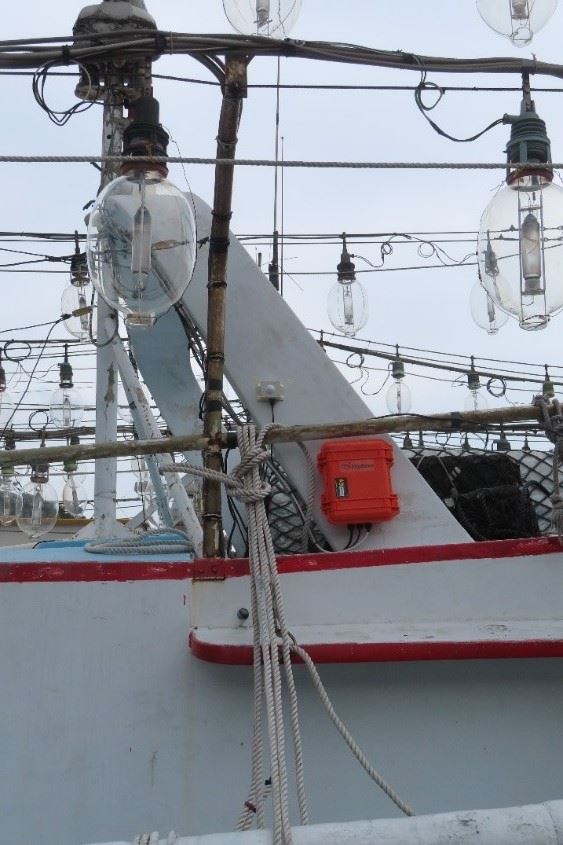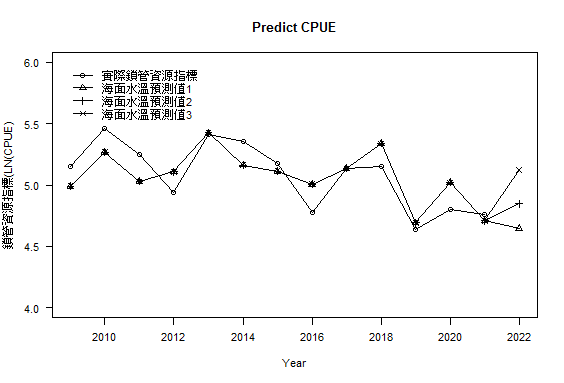In collaboration with the Central Weather Bureau, since 2017, the Fisheries Research Institute has provided predictions regarding neritic squid resources in the northern waters of Taiwan. By using the neritic squid resource prediction model, as established by the Fisheries Research Institute, and the sea surface temperature prediction data, as provided by the Central Weather Bureau, the trend of neritic squid resources in the northern waters of Taiwan has been accurately predicted for 4 years of the past 5 years. By substituting the three kinds of sea surface temperature prediction values provided by the Central Weather Bureau into the neritic squid resource prediction model, it is predicted that the neritic squid resources in the northern waters of Taiwan in 2022 will be higher than that of last year.
According to the Fisheries Research Institute, neritic squid is commonly known as small squid, while the large squid is known as Uroteuthis edulis, and there are three main fishing species in the waters around Taiwan, namely, U. edulis, U. chinensis, and U. duvaucelii. In the northern waters of Taiwan, U. edulis is the main fishing species, which is mainly fished with torch light nets during the fishing period from March to October every year. As neritic squid resources are vulnerable to changes in the marine environment, it is necessary to adjust the operation pattern in lean years with a poor environment to avoid adverse effects on resource sustainability due to inappropriate fishing.
The Fisheries Research Institute pointed out that the catch of neritic squids was between 3,000 and 5,000 tonnes in recent years. In order to conserve neritic squid resources, the Fisheries Agency, Council of Agriculture, Executive Yuan, established the Neritic Squid Fisheries Advisory Group in 2018, and issued and implemented Regulations on the Management of Torch Light Net Neritic Squid Fishery. At present, the main management measure is that "fishing vessels with torch light nets are prohibited from fishing between latitude 24 degrees 30' and 26 degrees North in February and October of the lunar calendar every year." In order to meet the management needs of neritic squid resources, since 2009, the Institute has conducted research on U. edulis in the northern waters of Taiwan. Since 2019, after accumulating the fishing data from the sample vessel for eight years, a prediction model for the change of neritic squid resources in the northern waters has been established. The construction of this model is mainly based on the factors of marine environmental data, and the prediction model is continuously adjusted according to newly acquired fishing data, in order to improve prediction accuracy. Since 2017, the Institute has cooperated with the Central Weather Bureau, which provides the prediction data of sea surface temperatures for the next 4 months to be substituted into the neritic squid prediction model, in order to predict the trend of neritic squid resources for the current year before the fishing period of each year.
This year, the Fisheries Research Institute took the sea surface temperature data of the tidal waters off northern Taiwan in February and the Arctic oscillation index in March as the prediction factors to predict the neritic squid resources. Three kinds of water temperature prediction values, as provided by the Central Weather Bureau, were used to predict the neritic squid resources, including the coupled sea-air forecast model of the Central Weather Bureau, the coupled sea-air forecast model of the Climate Prediction Center of the National Weather Service, and a mixed model, which was created by adding the former two into the SST statistical forecast model of the Central Weather Bureau. Among them, two groups of neritic squid resource prediction results showed an upward trend, which indicated that the amount of U. edulis resources in the northern waters of Taiwan is expected to rebound this year.
According to the Fisheries Research Institute, in order to collect more accurate and detailed fishing data as the basis of resource assessment, it installed an automatic collection system for fishing vessel operational information, as developed on the sample vessel. The collected operation information and sea surface temperature data of the fishery can further improve the accuracy of fishing data and develop more accurate neritic squid resource prediction models. In the future, the Fisheries Research Institute will continue to work with the Central Weather Bureau to provide oceanic predictions for neritic squid fishery operations in northern waters, which will help fishermen save fishing time. Moreover, it is estimated to increase the catch of fishing vessels by 10 to 15 percent and reduce fuel consumption by 10 to 15 percent.

Figure 1. An automatic collection system of fishing vessel operation information installed on a fishing vessel with torch light nets

Figure 2. Prediction chart of neritic squid resources in the northern waters of Taiwan in 2022